This post may contain affiliate links. Please read our policy page.
Designing an industrial hallway with recycled wood materials is a stylish and ethical choice. You'll create a unique space that tells a story while promoting sustainability. Start by selecting durable hardwoods like oak or maple, sourcing them from local suppliers or reclamation centers. Embrace versatile design styles, from modern industrial to rustic charm, and choose color palettes that complement natural wood tones. Incorporate textures and finishes to enhance visual interest, and consider custom fixtures for functionality. With a bit of creativity and careful planning, you can achieve a hallway that's both practical and memorable, revealing more possibilities along the way.
Design Highlights
- Reclaimed wood enhances the aesthetic appeal of industrial hallways while promoting sustainability and reducing environmental impact.
- Choose durable hardwoods like oak or maple for high-traffic areas, ensuring ethical sourcing for sustainability.
- Incorporate neutral color palettes and bold accents to harmonize with wood tones and create inviting atmospheres.
- Utilize varied textures and finishes to add character, while acoustic wood panels can improve sound quality in the hallway.
- Implement energy-efficient lighting and sustainable hardware to enhance functionality and reflect eco-friendly design principles.
Benefits of Recycled Wood
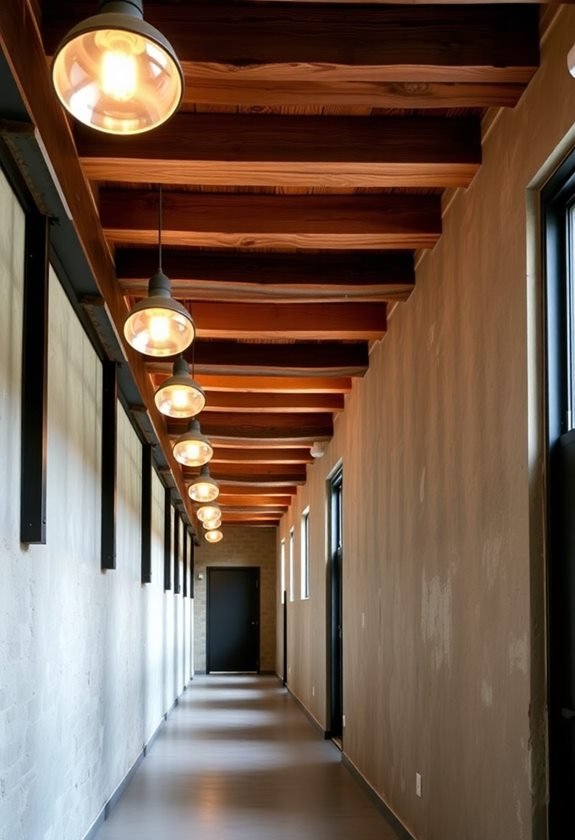
When you choose recycled wood for your industrial hallway, you not only enhance its aesthetic appeal but also contribute to a more sustainable future. Incorporating elements from industrial recycled wood decor adds a unique touch to your design while promoting eco-friendly practices. Recycled wood has a unique charm, often showcasing rich textures and colors that tell a story of its previous life. This adds character to your space, making it visually striking while maintaining an ethical approach to design.
Using recycled wood considerably lowers your environmental impact. By opting for materials that have already been harvested, you're reducing the demand for new timber, which helps preserve forests and biodiversity. This choice minimizes deforestation and decreases energy consumption associated with the production of new materials. Plus, recycled wood often requires less processing, further reducing its carbon footprint.
Practicality is another benefit that recycled wood brings to your hallway design. It's often more affordable than new hardwood, providing you with high-quality materials at a reduced cost. You can achieve a rustic, industrial look without breaking the bank. Additionally, recycled wood tends to be more durable, having stood the test of time, which means you'll enjoy longevity in your hallway's design.
Incorporating recycled wood not only transforms your hallway into a stunning passage but also aligns your choices with your values. By making this innovative decision, you're actively participating in a movement towards sustainability, ensuring your space is both beautiful and responsible. So go ahead, embrace the benefits of recycled wood and elevate your industrial hallway.
Choosing the Right Wood
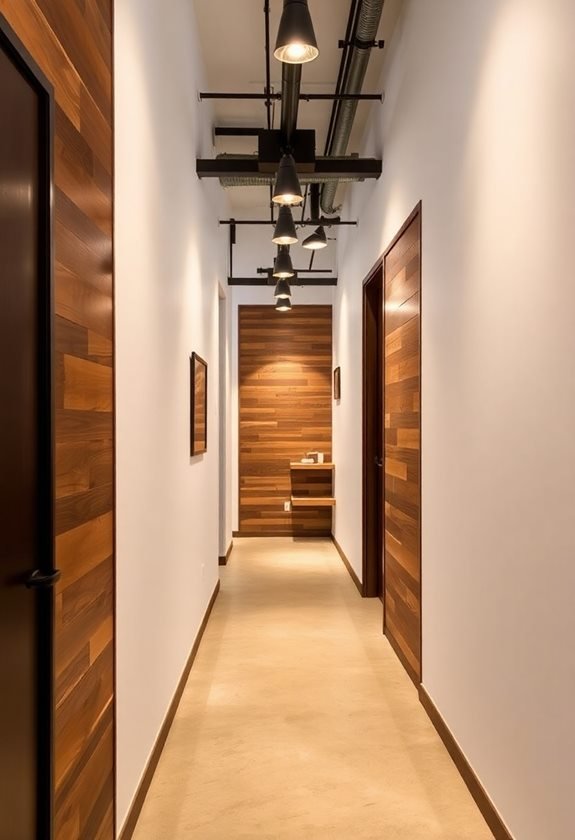
Selecting the right type of recycled wood for your industrial hallway can greatly impact both the aesthetic and functional qualities of the space. When you're choosing wood, consider its durability as well as its aesthetics to create a cohesive and lasting design. Transform your space with rustic decor can help inspire your choices. Reclaimed wood can vary considerably in strength, so it's vital to evaluate the specific type you select. Hardwoods like oak or maple are excellent choices due to their inherent durability, making them suitable for high-traffic areas.
Next, think about the visual appeal. The grain patterns, colors, and finishes of the wood should complement your overall design theme. A rustic look can be achieved with weathered barn wood, while a more polished approach might call for reclaimed wood that has been sanded and treated. Each type brings a unique character, so envision how the wood will interact with other materials in your hallway.
Don't forget about the environmental impact. Opting for recycled wood not only reduces waste but also supports sustainable practices. Confirm you choose wood sourced ethically to maintain the integrity of your project.
Sources for Reclaimed Wood
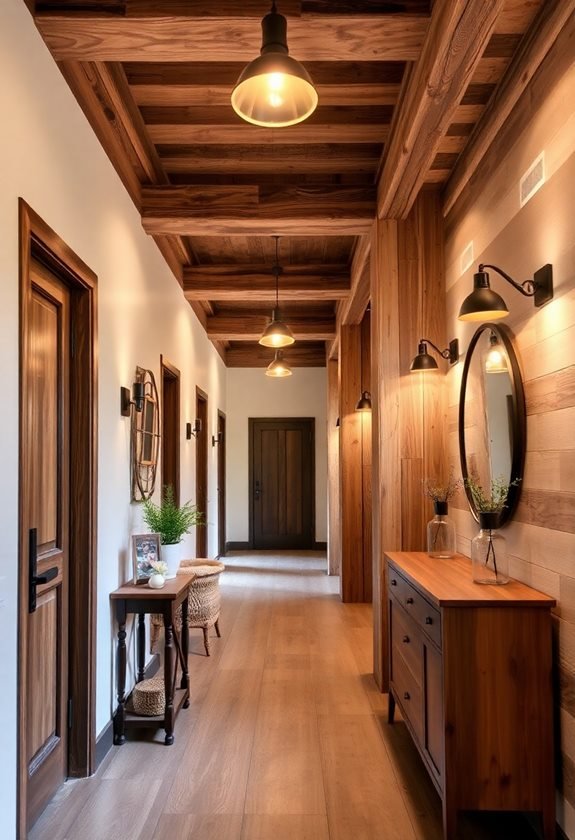
If you're on the hunt for reclaimed wood, you'll find a variety of reliable sources that cater to different needs and budgets. Start by checking out local suppliers who specialize in reclaimed materials. These shops often curate unique pieces from nearby demolition sites or community salvage projects, guaranteeing you get wood with a story. Additionally, many of these suppliers offer a selection of rustic charm with reclaimed material decor, allowing you to enhance your design with quality pieces that reflect your personal style.
Online marketplaces are another excellent option. Websites dedicated to reclaimed materials allow you to browse a vast selection of woods from various regions, giving you the flexibility to find exactly what you're looking for. Be sure to read reviews to guarantee you're purchasing from reputable sellers.
Don't overlook reclaimed warehouses, where you can often find larger quantities of wood for your project. These facilities typically salvage materials from historical sources, preserving a piece of history while providing you with beautiful, sustainable options.
Consider attending upcycling workshops too. Not only can you learn new skills, but you might also discover local artisans who specialize in furniture restoration. They often have access to reclaimed wood and can offer insight into sourcing materials ethically.
Lastly, keep an eye on demolition sites. If you can connect with contractors, you might find opportunities to acquire wood directly from jobs, often at a lower cost. By exploring these various sources, you'll not only find the right reclaimed wood for your industrial hallway but also support sustainable practices that benefit the environment.
Design Styles for Industrial Hallways
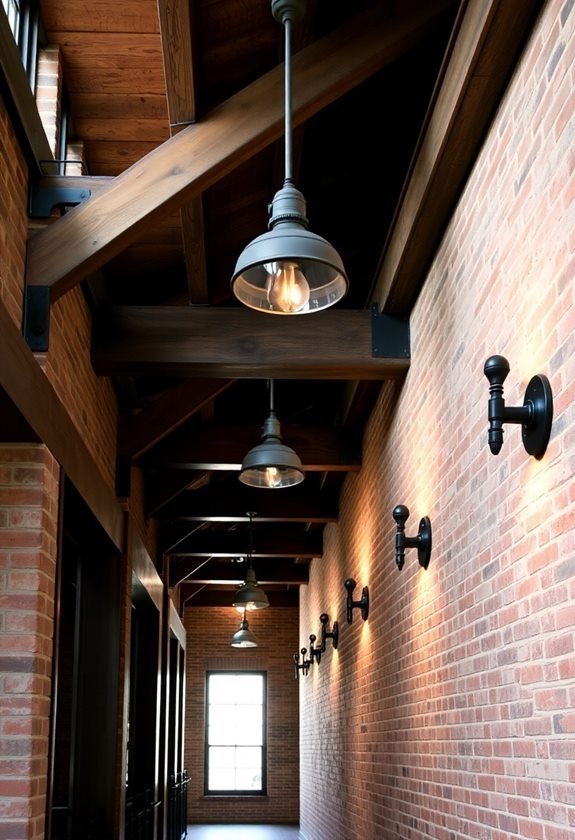
Transforming your industrial hallway into a stylish and functional space involves embracing design styles that highlight its unique architectural features. By focusing on the right elements, you can create a space that reflects modern industrial aesthetics while incorporating eco-friendly innovation. Utilizing industrial reclaimed decor not only enhances the visual appeal but also supports sustainable practices.
Here are four design styles to take into account:
- Modern Industrial: This style emphasizes raw materials, like exposed brick and metal fixtures. Use recycled wood for flooring or wall accents to enhance the urban appeal while maintaining a warm ambiance.
- Rustic Charm: Combine vintage elements with reclaimed wood to achieve a cozy, inviting feel. Adding rustic furniture can provide functional design that also embraces artistic expressions of craftsmanship.
- Minimalist Aesthetics: Opt for clean lines and uncluttered spaces. Use recycled wood in a way that focuses on space optimization, allowing your hallway to breathe and feel more open.
- Eclectic Mix: Blend different styles by incorporating various textures and colors. Vintage elements can coexist with modern industrial features, creating a dynamic atmosphere that showcases your personality.
Incorporating these design styles not only enhances the beauty of your industrial hallway but also aligns with ethical practices through the use of sustainable materials. By focusing on functionality and aesthetics, you can create a space that's not only visually appealing but also practical and eco-friendly.
Color Palettes With Recycled Wood
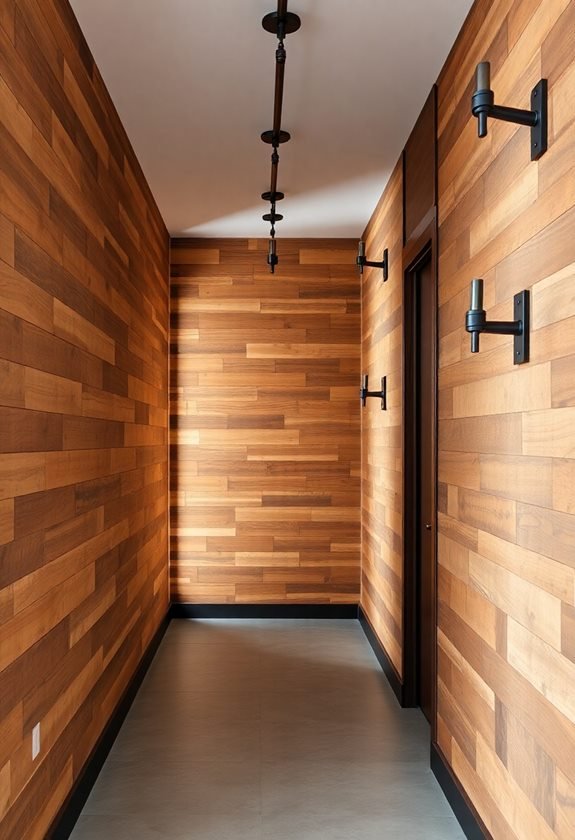
When it comes to choosing color palettes for your industrial hallway, consider how recycled wood can serve as a stunning foundation. The natural tones and textures of recycled wood not only evoke an earthy charm but also create a versatile backdrop that enhances your design. Embrace simplicity with recycled wood decor to bring warmth and character to your space. Think about how you can harmonize the wood aesthetics with colors that resonate with your vision.
Start by exploring neutral shades—grays, whites, and muted beiges—that complement the warm hues of the wood. These colors can create a calm and inviting atmosphere, promoting a sense of balance and tranquility. According to color psychology, such hues can reduce stress, making your hallway a welcoming space.
If you want to add a modern touch, consider bold colors like deep blues or rich greens, which can contrast beautifully against the natural wood. These colors can energize the space, making it feel alive and contemporary. Pairing vibrant accents with the rustic tones of recycled wood establishes an innovative visual dialogue that draws the eye.
For a cohesive look, you might incorporate accents in metallic finishes—like copper or brushed nickel—which can enhance the industrial feel while still feeling ethically sourced. Remember, each color choice should reflect the mood you want to convey, so let your creativity flow while staying grounded in the natural beauty of recycled wood. This approach not only guarantees a practical design but also promotes sustainability, making your industrial hallway a true reflection of your values.
Textures and Finishes
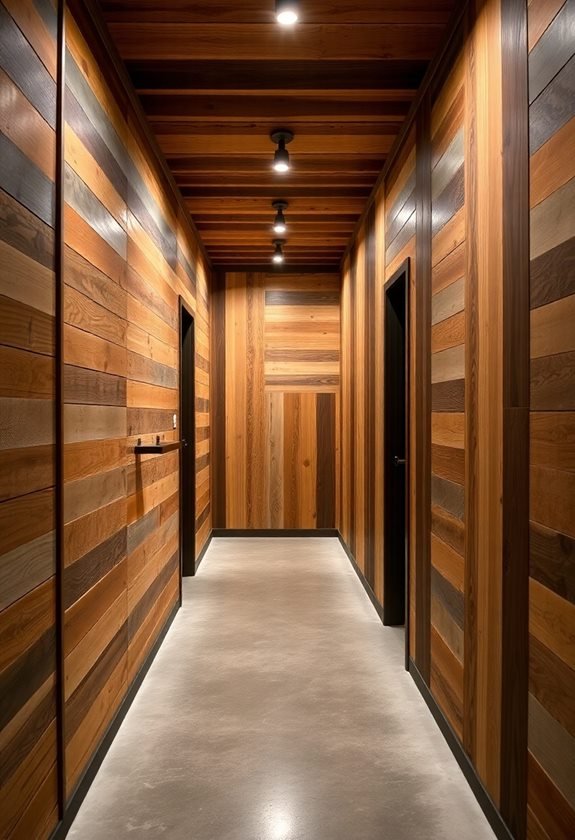
In designing your industrial hallway, the textures and finishes of recycled wood play an essential role in defining the overall aesthetic. The beauty of reclaimed wood isn't just in its sustainability; it's also in the unique character that each piece brings to your space. Here are four key elements to contemplate:
- Wood Grain: Embrace the natural imperfections and patterns in the wood grain. Each line and knot tells a story, adding depth and interest to your hallway.
- Surface Treatment: Choose finishes that enhance the wood's natural beauty while protecting it. Options like oils, waxes, or eco-friendly varnishes can boost durability without compromising the organic feel.
- Texture Variation: Incorporate different textures for a dynamic look. Pair smooth finishes with rough-hewn surfaces to create contrast and visual intrigue.
- Color and Sheen: Contemplate how the finish's sheen affects the ambiance. Matte finishes can evoke a rustic vibe, while satin or gloss can add a modern touch.
Incorporating Wood Into Walls
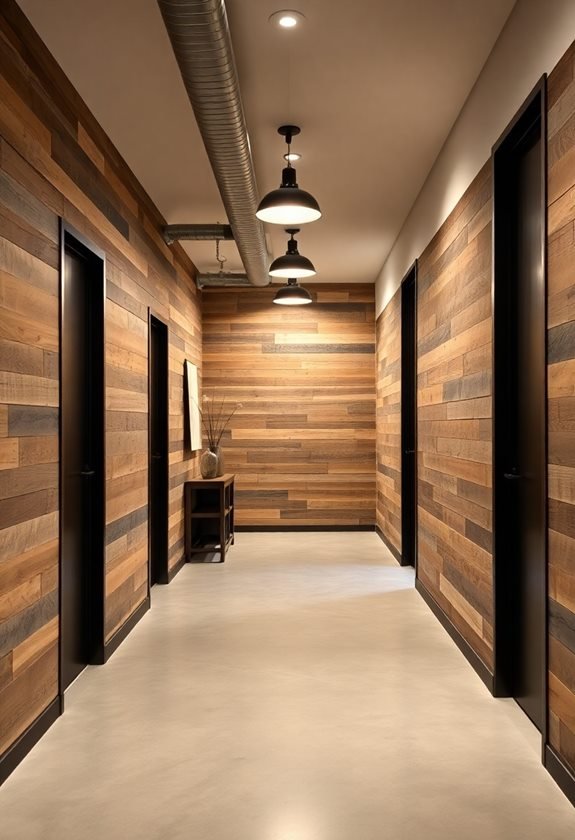
Incorporating wood into your walls can dramatically elevate the industrial feel of your hallway while also promoting sustainability. Using reclaimed wood not only showcases aesthetic appeal but also tells a story of resourcefulness. Consider various wood wall patterns, like herringbone or chevron, to create striking visual interest. These patterns can transform a plain hallway into a focal point, making it a conversation starter.
Acoustic wood panels are another fantastic option for enhancing your hallway. Not only do they add warmth and texture, but they also improve sound quality by absorbing noise. This is especially valuable in industrial spaces where echoes can disrupt the atmosphere. By choosing acoustic wood panels made from recycled materials, you'll further align your design with eco-friendly principles.
When selecting wood, look for character-rich pieces with knots and grains that reflect their history. This not only adds depth but also emphasizes your commitment to sustainability. You can mix and match different types of wood to create a unique look that's all your own.
Don't forget about finishing touches, like natural oils or low-VOC stains, which can enhance the wood's beauty while being mindful of the environment. Ultimately, incorporating wood into your walls allows you to create a beautiful, functional space that resonates with the core values of innovation, ethics, and practicality. Embrace the possibilities that recycled wood offers, and watch your industrial hallway transform into a stunning showcase of sustainability and style.
Flooring Options With Reclaimed Wood
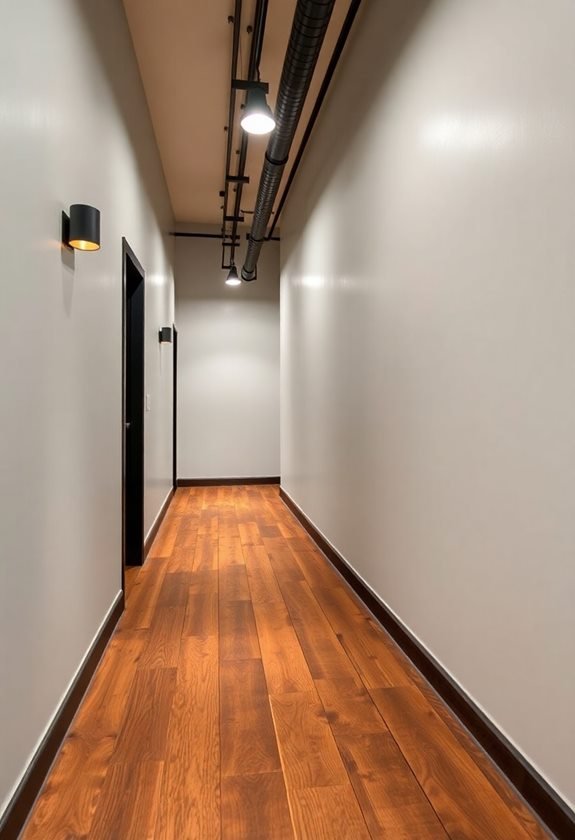
Choosing the right flooring can elevate your industrial hallway just as effectively as wood walls. Reclaimed wood options not only address sustainability challenges but also add unique character and aesthetic appeal to your space. Here are four flooring options to evaluate:
- Reclaimed Oak Planks: Known for their durability, oak planks can withstand heavy foot traffic while providing a warm, rustic look.
- Salvaged Barn Wood: This type of wood brings a historic charm and can often be sourced locally, reducing your carbon footprint.
- Reclaimed Heart Pine: Rich in color and grain, heart pine offers a striking visual impact and stands the test of time.
- Recycled Wood Composites: Combining reclaimed wood with other materials, these composites present a sustainable alternative that's easy to maintain and install.
When choosing your flooring, evaluate the maintenance requirements and how it fits into your overall design. Each option presents its own sustainability challenges, but the benefits of using reclaimed materials far outweigh the drawbacks. You'll find that they not only help the environment but also enhance the ambiance of your industrial hallway. Embrace the imperfections that come with reclaimed wood—every scratch and knot tells a story, contributing to the unique aesthetic appeal of your space. With the right flooring, you can create a lasting impression while staying committed to ethical design practices.
Custom Wood Fixtures
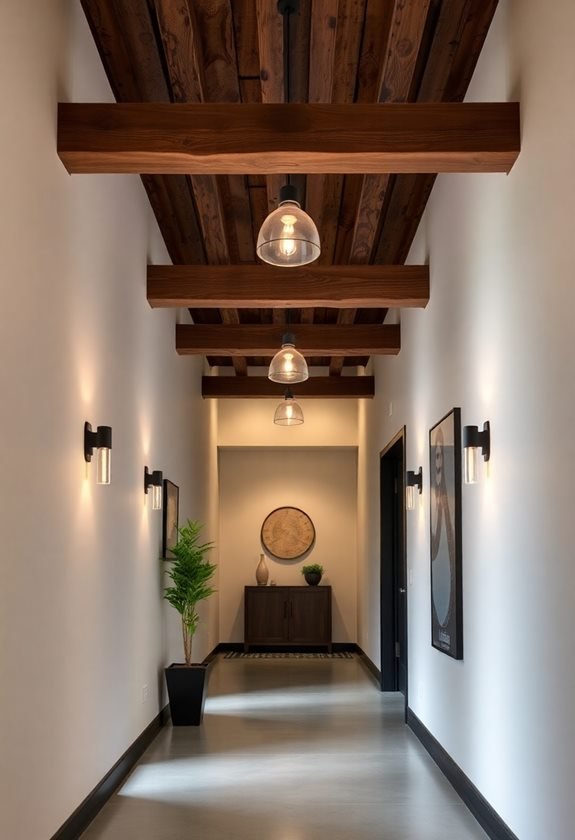
Transforming your industrial hallway with custom wood fixtures can greatly enhance its character and functionality. By integrating elements like custom shelving units and bespoke cabinetry, you can create a unique space that reflects your style while promoting sustainability. Using reclaimed wood not only minimizes environmental impact but also adds warmth and texture to the often stark industrial environment.
When designing your custom shelving units, think about your storage needs and the overall aesthetic you want to achieve. Floating shelves made from recycled wood can give your hallway an airy feel, while sturdier, built-in units can provide ample storage without sacrificing style. You can even incorporate hooks or compartments for added practicality, ensuring everything from books to bags has a designated spot.
Bespoke cabinetry presents another excellent opportunity to tailor your hallway to your needs. Consider creating a custom bench with storage underneath, perfect for putting on shoes as you head out. You could also design cabinets that blend seamlessly with your hallway's architecture, offering hidden storage for items you want to keep out of sight, like cleaning supplies or seasonal decorations.
Lighting Solutions for Hallways
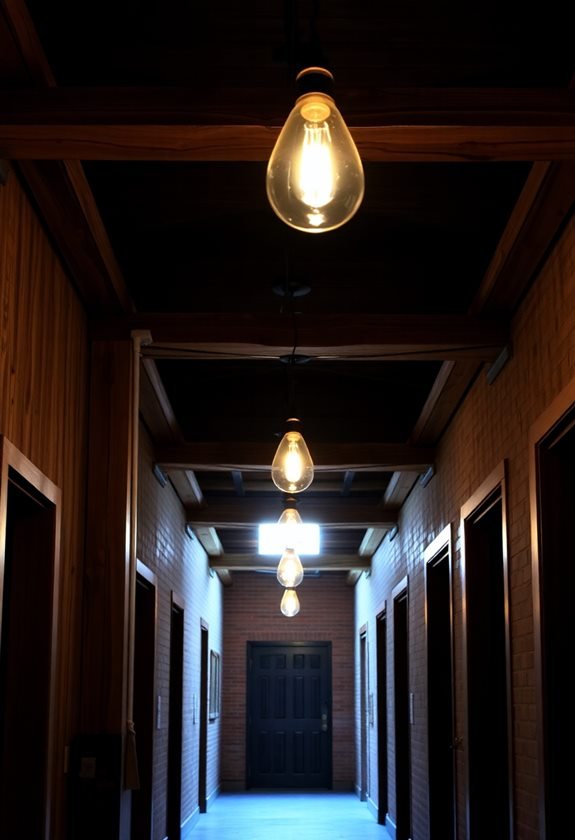
Five essential lighting solutions can elevate your industrial hallway, blending functionality with aesthetic appeal. By incorporating these strategies, you can achieve the perfect balance of light and design.
- Ambient Lighting: Start with ambient lighting to create a welcoming atmosphere. Consider LED options that offer energy efficiency and a warm color temperature, making the space feel inviting.
- Task Lighting: Integrate task lighting where needed, such as at entry points or along work areas. Adjustable fixtures can provide focused illumination, ensuring safety and ease of movement.
- Decorative Fixtures: Don't overlook decorative fixtures that enhance your industrial design. Choose pieces that complement the recycled wood elements, adding character while maintaining functionality.
- Motion Sensors: Installing motion sensors can considerably improve energy efficiency. They automatically activate lights when someone enters the hallway, ensuring you only use energy when it's needed.
Light placement is essential in maximizing the effectiveness of your lighting solutions. Position fixtures to eliminate shadows and enhance natural illumination during the day. Consider using dimmable switches to adjust brightness based on the time of day or specific activities, allowing you to create the perfect ambiance.
Sustainable Hardware Choices
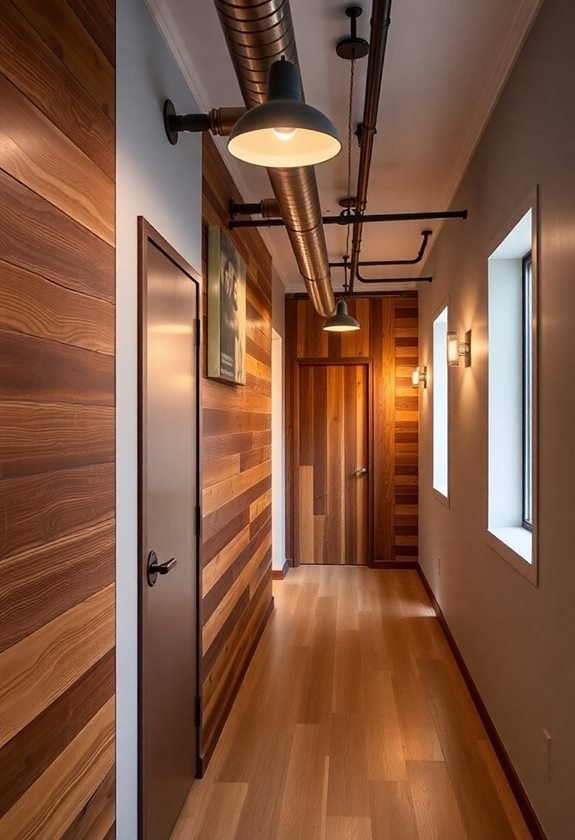
Selecting sustainable hardware for your industrial hallway not only supports eco-friendly practices but also enhances the overall aesthetic and functionality of the space. When you choose eco-friendly hardware, you're committing to materials that minimize environmental impact while providing durability and style. Consider using fixtures made from recycled metals or responsibly sourced materials. These sustainable fixtures can considerably reduce your carbon footprint while adding a unique touch to your design.
Look for low-VOC (volatile organic compounds) finishes to guarantee a healthier indoor environment. These finishes not only contribute to cleaner air quality but also maintain the industrial look you're aiming for. Hardware like door handles, hinges, and locks can be sourced from manufacturers specializing in sustainable practices, guaranteeing that all aspects of your hallway align with your eco-friendly vision.
Incorporating energy-efficient components, such as LED light fixtures and motion sensor switches, can further enhance your space's sustainability. These choices not only conserve energy but also lower long-term costs, making them practical investments. Don't forget about the importance of functionality; choose hardware that's easy to use and maintain, guaranteeing your hallway remains accessible and inviting.
Combining Wood With Other Materials
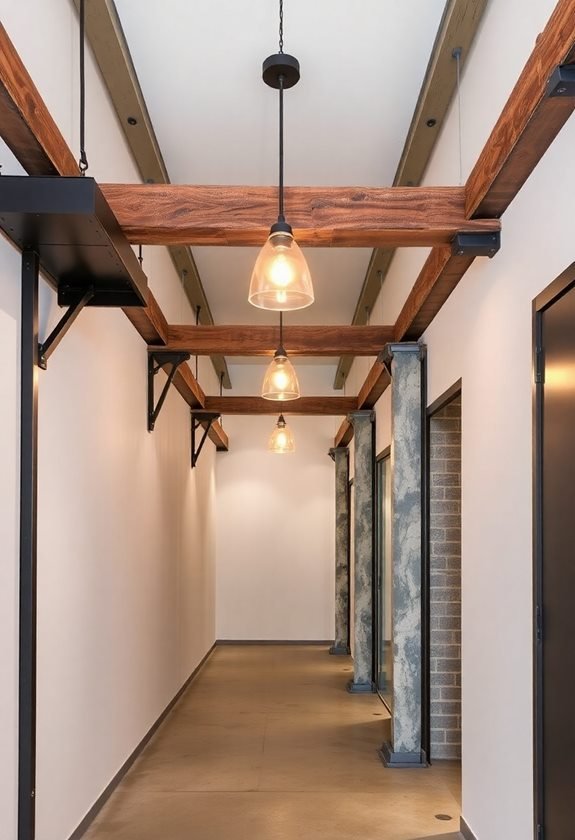
Incorporating wood into your industrial hallway design opens up exciting possibilities when paired with other materials. The right combinations not only enhance aesthetics but also bring functionality and sustainability to your space. Here are some innovative pairings you might consider:
- Wood Metal Combinations: Mixing the warmth of wood with sleek metal elements creates a striking visual contrast. Think of wooden wall panels complemented by metal railings or light fixtures, giving your hallway a contemporary edge.
- Wood Glass Integration: Using glass in tandem with wood can help maintain an open, airy feel. Consider incorporating glass partitions or shelving to showcase wooden accents, allowing light to flow through while highlighting your recycled materials.
- Wood Concrete Contrasts: The raw, industrial appeal of concrete pairs beautifully with reclaimed wood. You could use concrete flooring with wooden accents on the walls, creating a dynamic interplay between the two materials that grounds the space.
- Wood Textile Blends: Introducing textiles can soften the harder edges of wood and other materials. Think about using woven wall hangings or upholstered benches that incorporate wood elements, adding comfort and warmth to your industrial hallway.
- Wood Acrylic Fusion: Acrylic elements can add a modern twist to your design. Consider acrylic signage or decorative pieces that juxtapose elegantly with wood, creating a fresh, innovative look.
Maintenance Tips for Recycled Wood
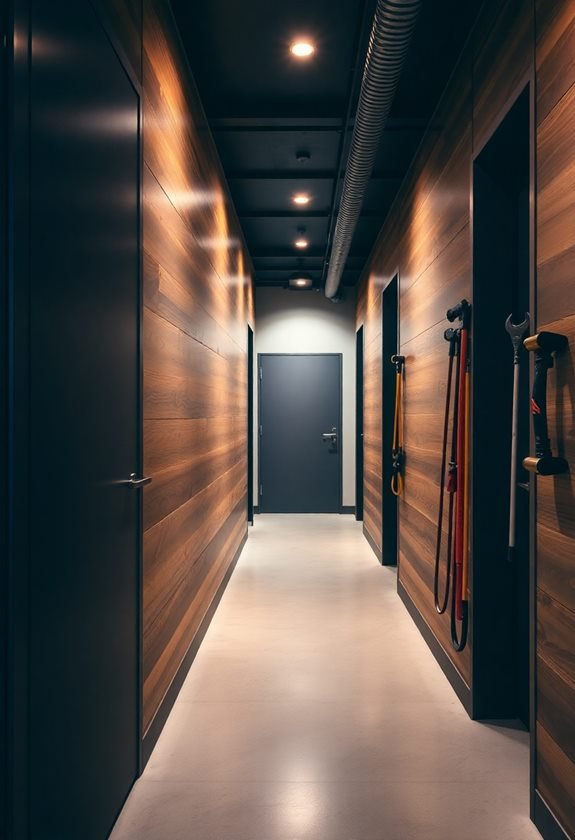
Maintaining the beauty and integrity of recycled wood requires a commitment to care that balances practicality with sustainability. To keep your recycled wood in top condition, you'll want to adopt a consistent maintenance frequency that suits your specific environment. Regular inspections will help you catch any issues early, so consider checking for signs of wear or damage at least once every season.
When it comes to wood care, start with effective cleaning methods. Use a soft-bristle broom or a vacuum to remove dust and debris, and for deeper cleaning, a damp cloth with a mild soap solution works wonders. Avoid harsh chemicals that can strip the wood's natural oils.
Incorporating protective coatings can greatly enhance the longevity of your recycled wood. Apply a high-quality sealant or finish to protect against moisture and UV damage. This not only preserves the wood's aesthetic but also plays an essential role in preventing warping.
Moisture control is crucial. Guarantee your indoor environment maintains a stable humidity level, as extreme changes can lead to wood expansion or contraction. You might need to make seasonal adjustments to your heating and cooling systems to keep things consistent.
Lastly, familiarize yourself with restoration techniques. If you notice scratches or dents, minor repairs can often bring back the wood's original charm. With these tips, your recycled wood can remain a stunning, sustainable feature in your industrial hallway for years to come.
Case Studies of Successful Projects
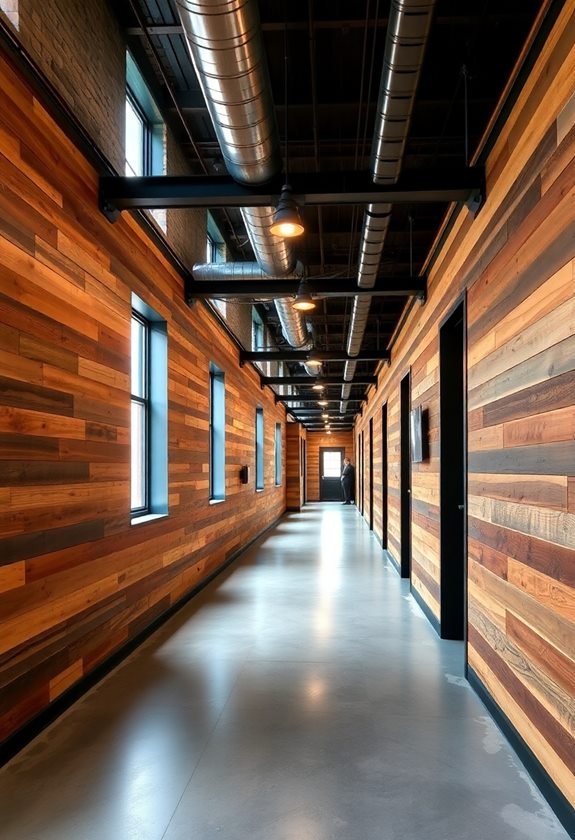
When it comes to transforming industrial hallways with recycled wood, real-world examples can truly inspire your vision. Here are four notable projects that highlight successful transformations using eco-friendly materials:
- The Old Factory Revival: This project focused on adaptive reuse, turning a historic factory into a vibrant community space. The hallway now features reclaimed wood beams, showcasing innovative designs that blend the old with the new, while preserving the building's character.
- Artistic Installations in an Urban Loft: Collaborating with local artists, this project transformed a stark corridor into a gallery of artistic installations. The use of recycled wood not only enhanced the aesthetic but also emphasized craftsmanship techniques that celebrate sustainability.
- Community Center Makeover: A community project renovated an underutilized space into a welcoming hub. Employing recycled wood throughout the hallway, they created an inviting atmosphere that encourages collaboration and interaction, showcasing the positive environmental impact of using eco-friendly materials.
- Historic Warehouse Conversion: In a successful effort for historic preservation, this project retained the original charm of a warehouse while incorporating modern elements. The hallway now reflects a blend of innovative designs and sustainable practices, highlighting the beauty of recycled wood.
These case studies demonstrate how thoughtful design, collaborative efforts, and a commitment to craftsmanship can lead to impactful transformations. By embracing these principles, you can create an industrial hallway that resonates with both style and purpose.
Future Trends in Sustainable Design
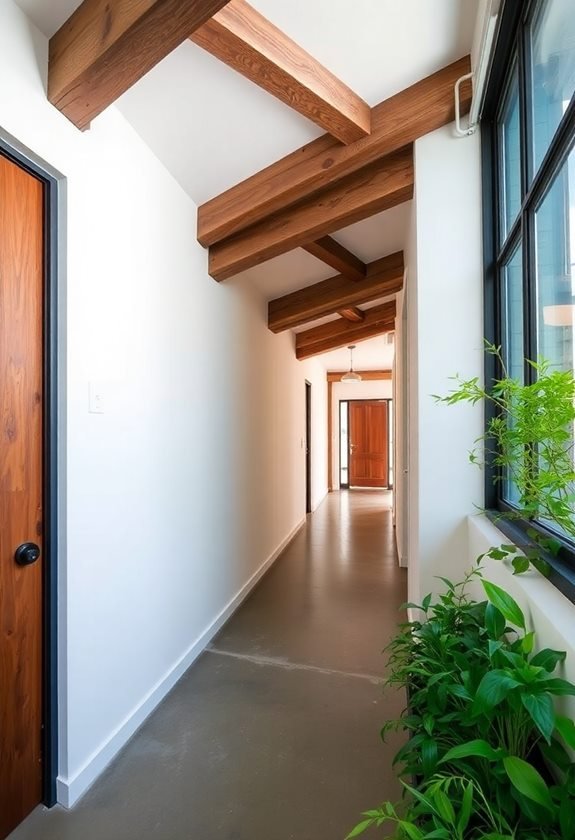
How can we shape the future of industrial design to be more sustainable? By embracing a circular economy, you can greatly reduce waste and environmental impact. This approach encourages the use of sustainable materials and promotes practices like adaptive reuse, where existing structures are repurposed rather than demolished. Implementing eco-friendly innovations in your designs not only minimizes the carbon footprint but also enhances the longevity and resilience of your projects.
Integrating biophilic elements into your designs can create more inviting spaces that connect people with nature, improving well-being and productivity. Consider using regenerative design principles that aim to restore and enhance ecosystems while meeting human needs. This mindset shifts the focus from merely reducing harm to actively creating positive environmental outcomes.
Zero waste strategies are becoming increasingly essential in sustainable design. Aim to eliminate waste throughout the lifecycle of your projects, from planning and construction to operation and demolition. This holistic approach can lead to considerable resource savings and lower operational costs.
Incorporating green architecture principles guarantees that your designs are not only aesthetically pleasing but also environmentally responsible. By prioritizing energy efficiency and sustainable resource management, you can create spaces that contribute positively to their surroundings.
As you move forward in your design practices, keep these future trends in mind. By focusing on sustainable, ethical, and innovative solutions, you'll be shaping a more responsible industrial landscape that benefits both people and the planet.



